
Challenges and solutions to healthcare disparities take precedence as healthcare providers, architects, and developers unite at Legat Architects’ Think Tank session on Health and Wellbeing Design.
On his way home from work, Jack, a husband and father of three, gets into an automobile accident that leaves him with a brain injury. Depending on the severity of his injury, Jack faces a slew of challenges: holding down his job, connecting with friends and family members, and of course, affording healthcare expenses.
This hypothetical but all too common scenario plays out frequently across the nation. Fortunately, there are organizations like Elmhurst, Illinois-based Synapse House that not only welcome people like Jack but also help them find happiness.
That’s the good news. The not-so-good news is that rehabilitation centers and the US healthcare system in general continue to contend with disparities in access to care. The negative outcomes range from underfunded facilities and overburdened caretakers to food deserts and obesity in low-income neighborhoods.
“Health and Wellbeing Design,” the fourth and final installment in Legat’s 2021 Think Tank series, addressed these inequalities head-on. Synapse House founder and Executive Director Deborah Giesler delivered the keynote. The following panel, moderated by Legat’s Sepideh “Sepi” Asadi, brought together healthcare professionals, designers, and developers to discuss hurdles and solutions to not only providing equitable care, but also instilling a more health-conscious mindset among those in underserved communities.
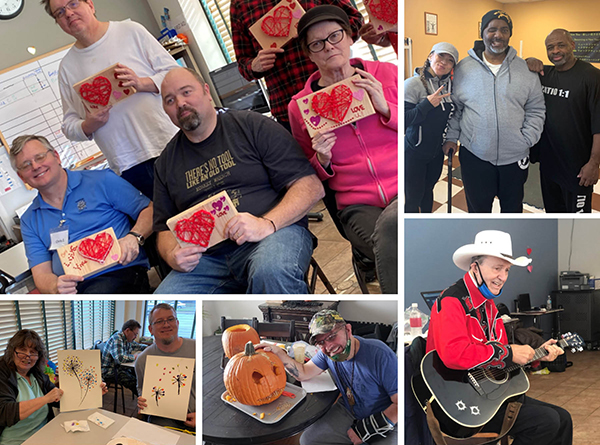
A Model for Physical and Mental Recovery
When she was a speech therapist on a hospital brain injury team, Deborah Giesler noticed that many of those coming out of the hospital would do rehab for a couple of weeks, then be left with a question: what now? This deficiency compelled her to launch Synapse House, which serves Chicago’s Cook County and the “collar counties” that surround it. Its mission is to “empower, engage, and employ individuals affected by brain injury and stroke.”
Synapse House offers a Clubhouse Day Program inspired by the International Clubhouse Model invented in 1943. The model, which has strict standards, allows Synapse House to enhance the quality of life for its club members through a wide variety of activities including exercise, arts programs, virtual gatherings (e.g., a virtual book club), and community outings such as grooming horses or stuffing stockings at a veterans’ organization.
Giesler said, “The Clubhouse Model not only addresses the person’s therapeutic needs but also boosts self-esteem.”
Synapse House also offers community support for veterans with brain injuries to help them reengage with their families, relearn daily living skills, and transition back to school, as well as acquire jobs and housing.
The Challenges to Brain Injury Treatment
During her keynote, Giesler shared many of the challenges that rehabilitation centers like hers face, from funding to transportation.
When a child with Down syndrome is born, parents get flooded with information about many kinds of organizations that can help. When a person acquires a brain injury, however, support is not as easy to find. Providers that are available, according to Giesler, are often overextended and in severe need of more space and more funding.
“It’s very difficult to provide people with acquired brain injuries the information and support they need,” she said.
Part of the problem, according to Giesler, are the vast differences between those who suffer from acquired brain injuries, as well as between the types of injuries. Those within a rehabilitation program might include everyone from a 16-year-old recuperating after a car accident or gunshot wound to an 80-year-old recovering from a stroke. Specific injuries can include any mix of physical, cognitive, and behavioral impairments.
The level of the injury complicates matters. The severity of a car accident injury, for instance, depends on a variety of factors such as speed and angle of impact, age of the injured, the post-accident quality of treatment, and how soon it was received.
Moreover, acquired brain injuries do not only result from traumatic incidents; infections like meningitis and neurological disorders like epilepsy can lead to brain injuries.
Thus, acquired brain injury rehabilitation specialists must consider these diverse factors and provide services accordingly.
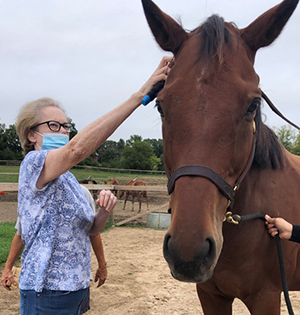
Disconnections: Funding and Transportation
Giesler’s vision of serving more people with acquired brain injuries (including more of those on the lower end of the economic scale) does not come without its obstacles. The biggest challenge is acquiring public funding—brain injury grants are scarce, and the pandemic has reduced donations.
Some funding agencies create stipulations that are difficult to achieve. Centers for Medicare & Medicaid Services (CMS), for instance, urges providers to take members into the community for activities … a difficult task for organizations like Giesler’s given staff shortages and pandemic restrictions.
She attributes some of the problems to the reality that the healthcare system and the community are often seen as two distinct entities. Consequently, healthcare providers are often reluctant to connect to community providers like Synapse House. Nevertheless, Giesler remains intent on partnering with outside organizations to bring her patients more comprehensive services.
Another barrier to providing care to those with acquired brain injuries is transportation to and from suburban recovery centers. Although major cities like Chicago have developed strong transportation networks within their boundaries, city-to-suburbs and cross-suburban transit options are often limited. “And if they can access trains or buses,” said Giesler, “those with acquired brain injuries have trouble navigating among the rushing commuters.”
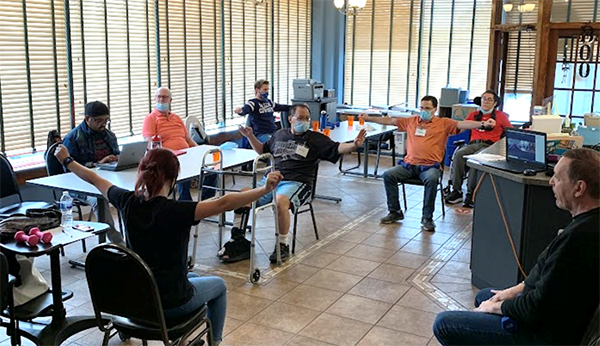
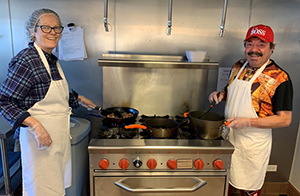
The Power of Routine: Advice to Architects and Interior Designers
Like many of its contemporaries, Synapse House also needs more space. The center, located in a converted pizza restaurant, has a good kitchen, but its largest space must do triple duty as dining room, gym, and even office space. Then there are the environmental challenges that come with those with hearing problems and light sensitivity.
Giesler envisions upgrades that will make her facility both more attractive and more accessible. Among the items on the Synapse House wish list are better entryways, larger bathrooms, a separate gym, patio space, a quiet room, and more storage space.
She challenges designers to help institutions like hers create unobstructed and equitable access to all areas. The spaces must respond to not only the physical needs, but also the mental (e.g., visual, memory, etc.) needs of those with disabilities … all while considering the caregivers.
A soothing interior environment will help those who suffer from headaches or auditory impairments. Members benefit when a space resembles a home and allows them to engage with their children and other family members.
Also critical for those with brain injuries are spaces that support routine. “There needs to be consistency with them always having a way to do the same thing every time,” said Giesler. “Familiarity with where menus, keys, and grocery lists go makes things less difficult for them and gives them more independence.”
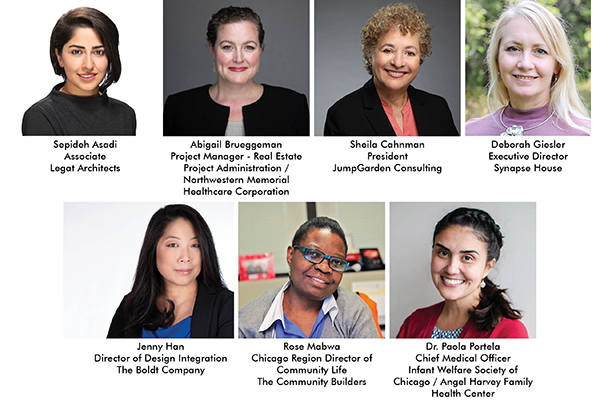
Transcending the Zip Code Ailment: Health & Wellbeing Design Panel
During her keynote, Deborah Giesler pointed out that, unfortunately, socioeconomic status is a major predictor of health. She shared a passage from the American Journal of Preventative Medicine:
A full 50% of health can be attributed to social determinants of health, the broad term that includes social, economic, and environmental factors. This is often summed up as: a person’s health is more a matter of one’s zip code than their genetic code.
The panelists agreed that money and language should not be impediments to people receiving quality healthcare. And yet, they are. This disparity plays out in a variety of ways. Some cannot afford medicine. Others have trouble accessing transportation to healthcare facilities. Still others do not understand the healthcare resources available to them.
These shortcomings and how to overcome them to achieve health equity became the focal point for much of the discussion within the Health & Wellbeing Design panel.
It Starts with Safety
Many of us take for granted the ability to go to a public park or a healthcare clinic without putting ourselves in immediate danger. Others, especially those in underserved communities, are not so fortunate.
At the foundation of effective healthcare access is safety, particularly for children. Dr. Paola Portela, Chief Medical Officer at Infant Welfare Society of Chicago’s Angel Harvey Family Health Center, said gang shootings are a real fear for many of the predominately Latino families that her organization serves.
Portela offered that healthcare providers who confront a similar dilemma can work with police and security teams to provide a safe space. She hopes to build an outdoor area where children can safely exercise.
The ER Is Not the Only Option
Abigail Brueggeman revealed that when many emergency room visitors are asked about their primary care physician, they do not have an answer. They see the ER as their only option, even for minor issues. This exemplifies a lack of knowledge about available resources.
Brueggeman, a project manager within Northwestern Memorial Healthcare Corporation’s Real Estate Project Administration, suggested that emergency departments can help these individuals understand and connect with primary care physicians. They can also educate these patients about immediate care centers as an alternative to ERs for unscheduled care for less serious injuries and maladies.

The Shift from Responsive to Preventative Medicine
Access is just one part of the equation—the shift away from the ER mindset and toward the preventative maintenance mindset can be incredibly difficult.
“It’s about education and exposure,” said Brueggeman. “If people don’t think healthcare is important, no matter what their socioeconomic status, they will have a poor health outcome.”
Organizations like hers can offer free clinics to those who have health issues but lack resources. Moreover, those receiving cancer care through Northwestern Medicine get access to their health and fitness centers.
Portela, who tries to position her organization as a “home away from home,” added that insurance companies are wise to incentivize preventative maintenance such as colonoscopies and mammograms. “Even if people don’t understand preventative maintenance,” she said, “they like the one hundred dollars they get for doing these procedures.”
Rose Mabwa, Chicago region director of community life at The Community Builders, shared that many in communities of color view hospitals as places that will use them as “guinea pigs.” Some residents, for instance, have been hesitant to be vaccinated because of disinformation stating that the Covid vaccines contain tracking devices or will change their DNA. Healthcare providers face the dual challenge of overcoming this distrust and convincing them to use the available resources.
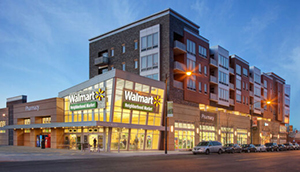
Covid: Technology Inequalities and Food Deserts
Throughout the pandemic, Rose Mabwa has attended community meetings in underprivileged neighborhoods to learn about what’s important to residents and businesses. One of the things that comes to the fore is access to technology. Among the problems are unaffordability, poor internet/cell phone service, and subpar technology literacy.
Covid-driven pressures compound the problem. Mabwa said, “Imagine the parent who’s struggling to go to work, put food on the table, and help the kids, but has no idea how to navigate technologies.”
An inability to access or comprehend current technology also means that these individuals are missing out on telehealth options such as access to doctors and opportunities for fitness and healthy cooking programs.
The pandemic has exacerbated another problem in underprivileged urban areas: unhealthy eating habits. Portela has seen some of the children that use her clinic gain 40 to 50 pounds over the pandemic. Many of these children’s families live in the middle of a “food desert,” meaning there is no way to easily or affordably access fresh, healthy foods.
“They can’t take a bus to Whole Foods or Mariano’s,” she said. “It doesn’t take a village anymore because everyone’s so closed off in large cities.”
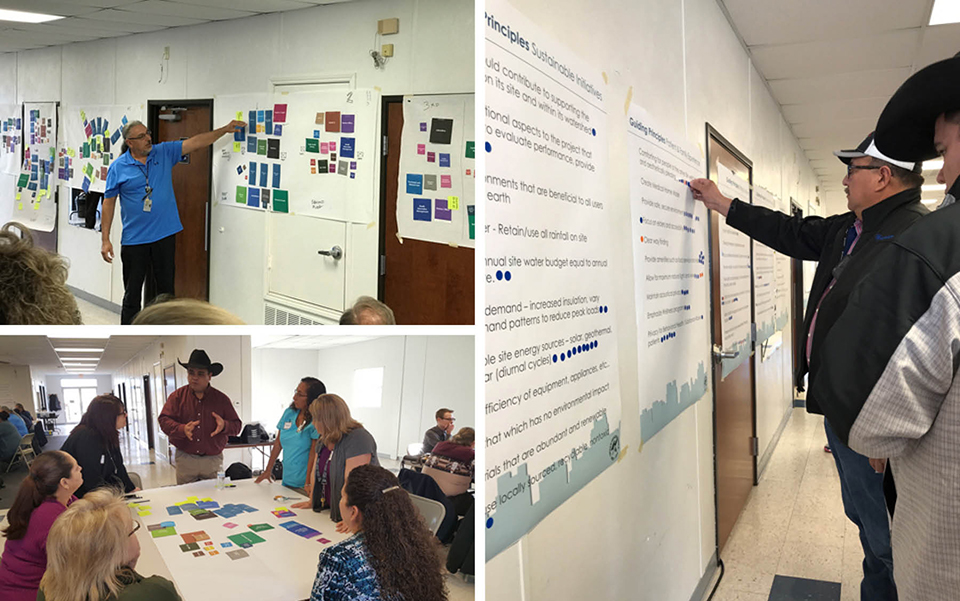
Building Right Means Hearing Their Voices
Residents in underserved communities are far more likely to support healthcare facilities—or any new facility, for that matter—when they are invited to participate in the planning and design processes.
“Maybe it’s not all about spaces, colors, and aesthetics,” said Jenny Han, director of design integration for The Boldt Company, “but rather that they feel respected and engaged throughout the process.”
Sheila Cahnman, president of JumpGarden Consulting, understands the nuances of engaging disadvantaged communities, especially those with Native American populations. She stressed that architects need to not only make sure constituents’ voices get heard, but also be aware of cultural differences so they can be integrated into designs.
When planning started for a new healthcare clinic in Rapid City, South Dakota, tension mounted between government officials and the affected tribes. Cahnman said, “Originally, the tribes were told, ‘You’ll get a clinic, but this is what it will be based on our analysis.’”
Her firm was brought in to lead community engagement sessions. The meetings included Indian Health Services representatives, nonnative clinical staff, and members of native tribes. According to Cahnman, the tribe members were grateful. “Other times, architects came in and said, ‘Here are your options. Pick one.’ This was the first time their input was sought early to inform the design.”
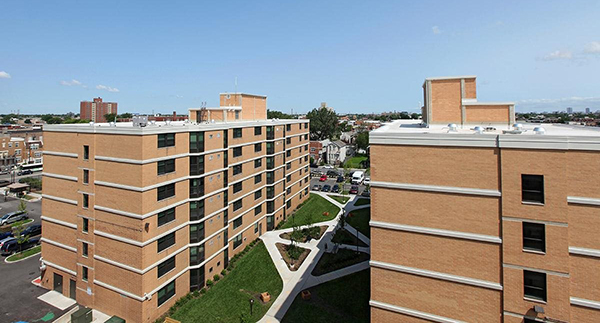
Mabwa also focuses on ensuring that facilities in low-income neighborhoods respond to the needs of inhabitants. After meeting with residents on Chicago’s West Side, for instance, The Community Builders led a rehabilitation of the Oakley Square Apartments. This project converts first-floor units into a health clinic, classrooms, a yoga room, and more.
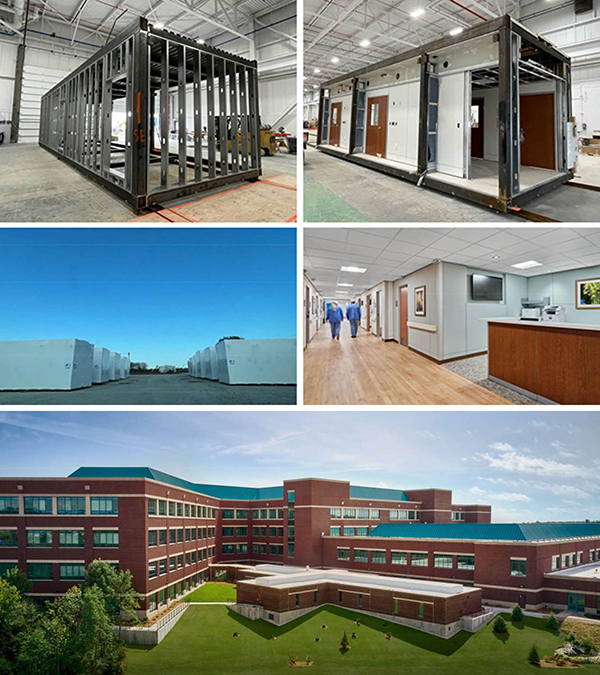
The Value of Predictability: Prefabrication for Healthcare Facilities
Jenny Han’s company helps healthcare providers rise to some of the challenges of inequity, thanks to prefabrication and modular construction. Prefabrication involves factory-assembling parts of a building (e.g., walls, mechanical/electrical/plumbing systems) traditionally done at the construction site. Modular refers to the standardized, self-contained units that are built within the factory.
Among the benefits of prefabrication, according to Han, are faster construction time (because work on site and in the factory happen simultaneously), fewer errors (due to a higher level of detailing and an integrated design process), and safer construction sites (fewer opportunities for accidents in a controlled fabrication environment). When it comes to shipping, the size of modules is only limited by road width and bridge heights.
Han also dispelled misconceptions partly attributable to mobile homes. “People think prefabricated facilities are lower quality,” she said. “Actually, they’re higher quality because the controlled factory environments create less dust, less waste, and straighter lines. The predictable nature of modular design and construction means a consistent, high-quality product. And because Boldt is a modular designer/manufacturer/builder, the prefabricated solutions can blend seamlessly in the neighborhoods and healthcare campuses.”
This repeatability makes modular construction a viable option for enhancing healthcare offerings in disadvantaged areas. Han gave examples of clinics, micro-hospitals, and surgery centers. She also pointed out that with prefabrication, “an underserved community gets just as good a product as anywhere else.”

National Healthcare Equity: The Heart of the Matter
When he was in his thirties, Jered had a stroke, fell into a coma, and went into heart failure. A device kept his heart pumping. During an exercise class at Synapse House, he received a call from his mother. After he got off the phone, he said, “I’ve got a heart!”
Today, Jered is not only a clubhouse member, but he also sits on Synapse House’s board of directors.
Achieving more outcomes like this requires a monumental shift in how we view healthcare. The US healthcare system faces a quandary: though we stand at the forefront of technological advancement, the exorbitant cost for care widens the gap between the haves and the have-nots, leading to zip code disparities.
“We have to stop thinking about people as commodities,” said Mabwa. “Many countries look to us as a leader. We have to fix our house first, then things will fall into place.”
Cahnman added that the healthcare system is just the top of the pyramid in terms of achieving health equity and living a healthy life.
Han suggested that the US needs to take cues from countries with more successful and comprehensive systems and enact policies accordingly.
And just who is responsible for addressing these disparities? Brueggeman said the solution comes in the commitment of “all of us, not just healthcare providers and governments.”
Contact us to learn more about healthcare design or comment below to share your thoughts on this post.


